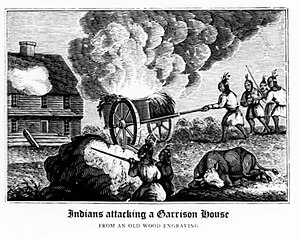King Philips War
| King Philip's War | |||||||
|---|---|---|---|---|---|---|---|
| Part of the American Indian Wars | |||||||
 An artist's rendition of Indians attacking a garrison house |
|||||||
|
|||||||
| Belligerents | |||||||
|
Wampanoag Nipmuck Podunk Narragansett Nashaway |
Mohegan Pequot |
||||||
| Commanders and leaders | |||||||
|
Metacomet ("King Philip") † Canonchet, chief of Narragansett † Awashonks, chief of Sakonnet Muttawmp, chief of Nipmuck |
Gov. Josiah Winslow, Gov. John Leverett, Gov. John Winthrop, Jr., Captain William Turner, Captain Benjamin Church, Captain Michael Pierce |
||||||
| Strength | |||||||
| approx. 3,400 | approx. 3,500 | ||||||
| Casualties and losses | |||||||
| approx. 3,000 | approx. 1,000 | ||||||
King Philip's War (sometimes called the First Indian War, Metacom's War, Metacomet's War, or Metacom's Rebellion) was an armed conflict between American Indian inhabitants of present-day New England and English colonists and their Indian allies in 1675–78. The war is named for Metacomet, the Wampanoag chief who adopted the English name Philip due to the friendly relations between his father and the Mayflower Pilgrims. The war continued in the most northern reaches of New England until the signing of the Treaty of Casco Bay in April 1678.
Metacom (c. 1638–1676) was the second son of Wampanoag chief Massasoit, who had coexisted peacefully with the Pilgrims. He succeeded his brother in 1662 and reacted to rising tensions between the Wampanoags and the colonists. At Taunton in 1671, he was humiliated when colonists forced him to sign a new peace agreement that included the surrender of Indian guns. Officials in Plymouth Colony hanged three Wampanoags in 1675 for the murder of an Indian, and Metacom's followers and allies launched a united assault on colonial towns throughout the region. Metacom's forces gained initial victories in the first year, but then the Indian alliance began to unravel. By the end of the conflict, the Wampanoags and their Narragansett allies were almost completely destroyed. Metacom anticipated their defeat and returned to his ancestral home at Mt. Hope, where he was killed fleeing an English attack.
The war was the single greatest calamity to occur in seventeenth century Puritan New England and is considered by many to be the deadliest war in the history of European settlement in North America in proportion to the population. In the space of little more than a year, twelve of the region's towns were destroyed and many more damaged, the colony's economy was all but ruined, and its population was decimated, losing one-tenth of all men available for military service. More than half of New England's towns were attacked by Indians.
King Philip's War began the development of a greater European-American identity. The colonists' trials, without significant English government support, gave them a group identity separate and distinct from those who lived in Britain.
...
Wikipedia
